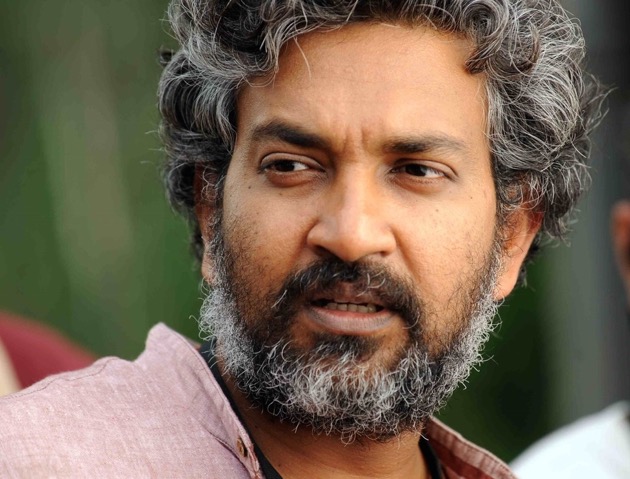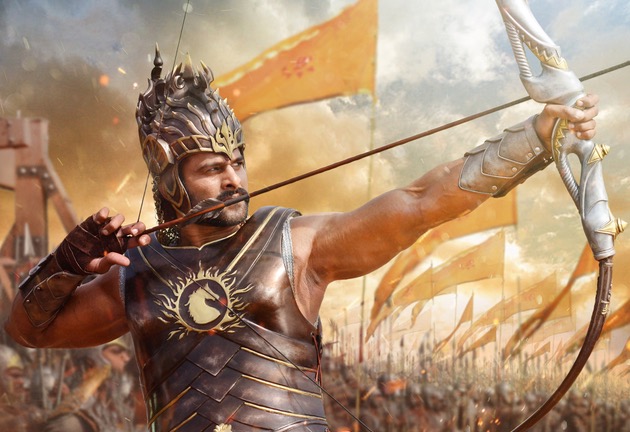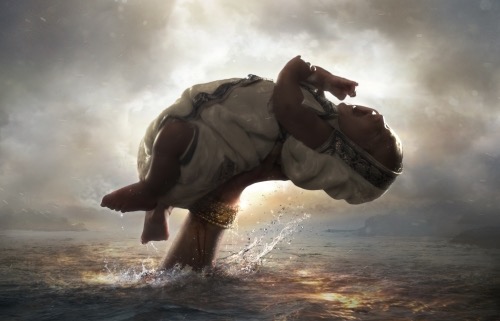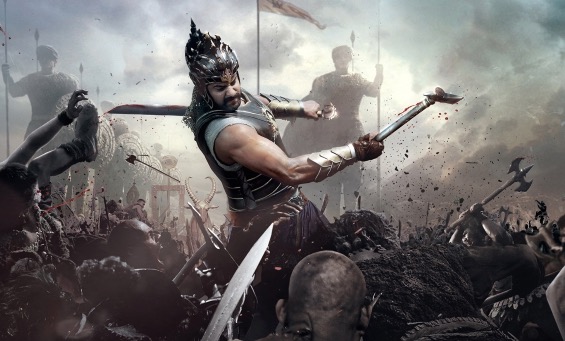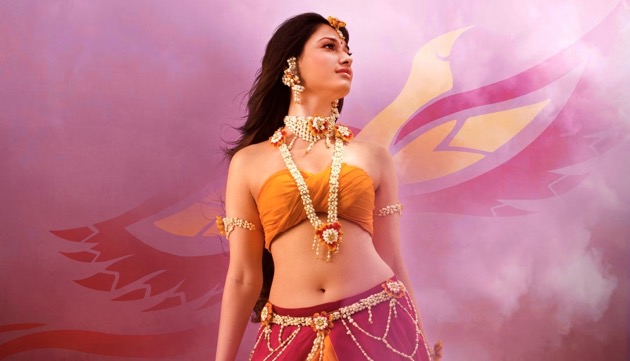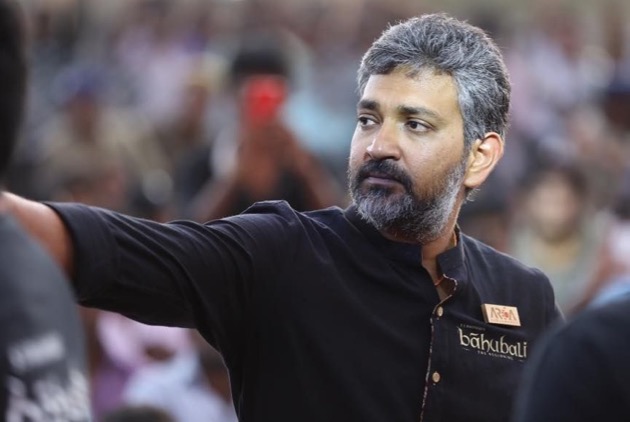Interview: Director SS Rajamouli On BAAHUBALI, An Epic Undertaking
CLICK THROUGH THE IMAGES BELOW FOR THE FULL INTERVIEW






Where did the idea for Baahubali originate?
Actually my fascination started from a very early age. My first foray into mythology and period drama was through comic books. Amar Chitra Katha is an Indian comic book that dealt with mythology, folklore, history, everything. Every classic Indian tale was in those comic books. I used to read them more than my school books.
Luckily my father and mother never discouraged me, in fact they encouraged me to read more and more stories and comics. I was heavily into those comics and also the Indian mythologies of Ramayana and Mahabharata, I had the children’s versions of them. My grandmother gave those to me at a very early age. So I was really fascinated with big palaces, kings on horses, battles and all of that from a very early age.
But this particular story is completely original, right?
Yes, it’s completely fictitious, including the historical period. When I became a director my fascination was still there. Obviously the budgets need to be much bigger to make these kinds of films, but about 7 or 8 years years ago I ventured into semi-mythology in a small part of the film Yamadonga, which paid off well. Then we made Magadheera, half of which has a period setting.
I must confess I’ve only seen the scene where a car flies into a helicopter.
That’s the best part! But the period stuff also paid off very well, which gave me the confidence to do a fully-fledged historical film. So that is the basis of how I came to Baahubali. But actually what inspired me to make this film were the characters created by my father. He is a story writer. He wrote almost all my films. He created these very strong characters, and the friction between them created a space for lots of emotional moments.
One of the key relationships in the film is between a father and son, a man’s efforts to become who his father was supposed to be. Do you think your father was trying to tell you something?
[Laughs] Nothing for me, but the characters in Baahubali are not the kinds of characters I have dealt with before. Most of my characters in my previous films are very black and white, but in Baahubali the power game, the politics between the six or seven principle characters, not all of them are black and white. There are a lot of grey shades to their characters, which gives a lot of depth to the movie.
CLICK THE IMAGE ABOVE TO CONTINUE ...
At what stage of development did you realise that this project was going to be BIG?
[Laughs] We still haven’t realised that yet! It keeps growing bigger and bigger. We knew from the outset that it was going to be big, in all aspects, not just the budget, but the timeframe, everything. But it was like a cloud, you don’t know what is there. After a certain distance, when you enter into the cloud the end is not still here, it is still further away. So it kept on growing bigger, but because of my producers, I should say, because of the confidence they have in the project, and in me, they were willing to travel along with me.
It’s one thing to convince your investors to keep paying for this, but to get your talent - the actors particularly - on board for what? 450 shooting days? That’s a very special commitment for them to make.
Probably they had a better idea than me. Not only the actors, but the technicians also. Like the senior technician Sabu (Cyril), who was the architect of the film; my cameraman Senthil (Kumar), who has worked with me on five or six films. When I narrated the story to them they said “Okay, we are not going to work on any other films for the next two or three years”. They knew. I didn’t know, but they knew.
Same thing for the talent, particularly Prabhas. I would say, “Okay, we are doing a war movie, we’ll be doing it for about 50 days” and even then he would say “Come on, I know you are going to take longer than that!” So, he was prepared for the film to take more than two-and-a-half years. And he didn’t accept any projects, he kept himself free. More than me I think they had better clarity and more confidence in the film.
We were shown one of the sets at Ramoji Film City, and you can really feel the mythological scope of the film. Have you found your vision for the film has changed at all over this long period period?
Not really. What is driving the film are the characters themselves. They are very much etched into my mind - how they should talk, how they should behave and how I should present them on the screen. That is the driving point, even for the sets that we build and he battles that we conceive, everything is derived from the characterisations. So because we are very clear about this foundation nothing is actually changing. It is the details that we are working in more and more, but the principle structure has remained the same. It hasn’t changed, not even a tiny bit, since the day we conceived the story.
So did you know on Day 1 what you were going to be shooting on Day 200, for example?
Not in that sense. In that sense we are very off the mark. But what we want to achieve on Day 400 is the same. The only thing is we thought we’d achieve it on Day 200.
There will be a lot of visual effects in the film when it is finished, but I understand you used a lot of real extras too in the battle scenes.
Yes, at its peak I think we had about 2,000 to 2,500 people on the set. Not every day, but that’s quite a challenge, believe me! And hundreds of horses, and elephants! But believe me, humans are more difficult to control.
CLICK THE IMAGE ABOVE TO CONTINUE ...
How would you describe the tone of Baahubali?
Well, in Hollywood cinema films often keep a uniform tone throughout the drama, from beginning to end, while in Indian Cinema we don’t do that. Reel 1 may have one kind of emotion, reels 3 and 4 may have a completely different tone, and it will change again. It keeps changing. But that is how the dramas in Indian Cinema are. Maybe sometimes we make a bad job out of it, sometimes we make a good job of it.
Let’s take the Mahabharata, it starts with just happiness, and then it goes into rivalry and jealousy, then it goes into something else. It keeps changing. But when you go to a bird’s eye view you’ll see a theme that runs from beginning to end.
So, the Mahabharata has been an influence on me in all aspects, so I try to put that in every film. But this will be more towards that epic tone. It will have a uniform emotion that drives the film from beginning to end, but it will also have that Indian way of shifting between different emotions. It’s a combination of both, but there will be one central theme that is running throughout.
And what is that one central theme?
[Laughs] That’s a difficult question…
And you posed it yourself!
I would say it is a sense of honour. A sense of pride and loyalty. These hardcore emotions which have manifested in these characters, sometimes to a fault, and the friction that causes - that is the theme that drives my whole film.
CLICK THE IMAGE ABOVE TO CONTINUE ...
In the past your films have been considered quite violent, and in the footage we were shown I saw at least one beheading. Are we going to see a lot of that in Baahubali?
I have certain ways of including violence in my films. When you feel the anger of the character, if you are able to transfer his anger into the audience then the amount of violence that you show onscreen doesn’t feel repulsive. And if you are not able to do that, that will make you twitch in the theatre. That’s my commercial viewpoint.
Sometimes in a story I need to say that someone has been beheaded. If there is no emotion attached to that point but it’s right for the movie then I’ll do it very suggestively, and not show the blade cutting the neck, or coming close, I’ll never show that. Only the audience will get a feeling that he has been beheaded. But if it is a very emotional surge, where the hairs on the back of your hand are standing up, then I’ll try to be more graphic. That is the course I usually take. Visually I try not to show the blood and gore on the face of it.
I think there may be a certain expectation for violence when watching hand-to-hand combat in a film like this.
Because it’s a war, and war is about killing people, then we need a bit of violence, but in the final cut, when you see it, we will be toning down a lot of the colour, or maybe the music. For example the beheading shot that you saw, by the time you see it in the theatre it might be just a silhouette. So we will be toning some of the violence down.
I also saw a chariot with a massive circular blade in the front…
That war machine is an actual invention, it’s really a workable model. We were browsing, doing some R&D and we found that machine design and we actually make it for real, and it was working. It’s a chariot which runs and the blade actually spins, but if you actually put it in a war it would be quite devastating - you can’t imagine the amount of bloodshed it creates.
CLICK THE IMAGE ABOVE TO CONTINUE ...
On the use of music in Indian Cinema...
For the longest time, song and dance have been very much part of Indian film, we cannot take them away. But after a certain time it became the norm to have three songs in the first half, three songs in the second half, and they started to dictate the screenplay of the film. The story is moving along, and now it’s time for a song! So somehow we needed to stop the story and put a song in. So that started making the screenplay, sort of, weak, instead of the songs being a highlight of the film.
So, I started breaking away from that. Six songs, why should we have six songs? Let’s cut the last song because it’s far too long. It was a bit of a mould-breaker the first time I did that. “How can you have only five songs in a commercial film?! How can you do it?!” Of course, after the film became successful no one ever noticed that it only had five songs, so from then on I started pulling out all the songs that are not required. Maybe one song, ok, for the friendship’s sake, or something, because the hero has a huge reputation that he dances so let’s have one song. I’ll compromise on maybe one or two songs, but I started removing songs if they were not at all important.
In Baahubali what we tried to do is cover a lot of story in the songs. Maybe a Western audience is not used to the songs coming into the film unless it is a musical…but we somehow derived the grammar for the story within the songs.
We have a very very old tradition of street storytelling. As the play is going on, when the emotion is at its peak, when I want to convey a very strong emotion, we resort to poems rather than dialogue. A song or a poem or whatever. It’s a very old tradition across India, not just Telugu, everyone has the same. I think when cinema started that is something that flowed into filmmaking. And that gradually translated into the songs that we have now.
So it has a grammar, you should have a very strong emotion that leads into that song. If it is just “time for the song”, let’s cut the scene and have some nice groovy moments, it won’t work. You need to have one strong emotion to tell in that song. That will work.
So in Baahubali, how many songs do you have?
Actual singing kind of songs, we have three in Part 1, including one on the waterfall, in the scene you have seen. There he has a strong emotion which is pulling him up, so that is the thread that he goes up on. The song is justified in that way.
CLICK THE IMAGE ABOVE TO CONTINUE ...
Now you are just a few months away from Part 1's July release date. When can we expect to see Part 2?
Right now we are so completely submerged in this part, getting out this part, we haven’t had much time to think about Part 2, but the general idea is next summer.
Was it always the plan, right from the beginning, to do two parts?
Actually what we thought is we would complete the entire shooting part for all the parts and then we will start post-production on Part 1, then after that has been released we will start post-production on Part 2. So we thought we will have about 3 or 4 months gap between Part 1 and Part 2. That was the initial idea, but when we started going through it, it was going on and on and on. We have shot about 40-50% of the second part so far, so we prioritised the shooting of the first part.
Was it always very clearly defined what would be in Part 1 and what would be in Part 2? Did that change much during editing?
That is always there. Just like when you make any film, you always contemplate shifting some parts here, taking something from there. So we thought about changing some scenes in the first part and using them in part two, but that was only for a very brief moment. We were always pretty sure where we were going to end Part 1 and where Part 2 would start.

More about Baahubali
- Eric Ortiz's Favorite Movies Of 2017
- Marshy's Favourite Asian Movies of 2017 Part 1
- Review: SS Rajamouli's BAAHUBALI 2: THE CONCLUSION Shows A Director on the Verge of International Stardom
- Check Out These New Posters For BAAHUBALI 2: THE CONCLUSION, India's Biggest Film Event
- Blood, Fire, & Betrayal Rule In BAAHUBALI 2: THE CONCLUSION Trailer
Around the Internet
Recent Posts
Leading Voices in Global Cinema
- Peter Martin, Dallas, Texas
- Managing Editor
- Andrew Mack, Toronto, Canada
- Editor, News
- Ard Vijn, Rotterdam, The Netherlands
- Editor, Europe
- Benjamin Umstead, Los Angeles, California
- Editor, U.S.
- J Hurtado, Dallas, Texas
- Editor, U.S.
- James Marsh, Hong Kong, China
- Editor, Asia
- Michele "Izzy" Galgana, New England
- Editor, U.S.
- Ryland Aldrich, Los Angeles, California
- Editor, Festivals
- Shelagh Rowan-Legg
- Editor, Canada


